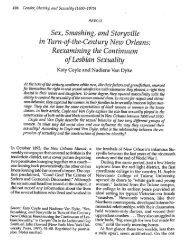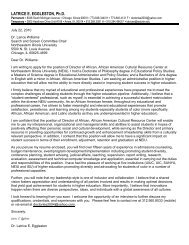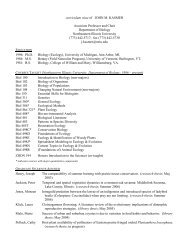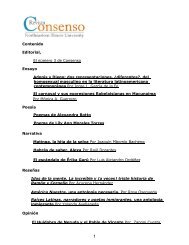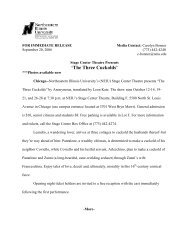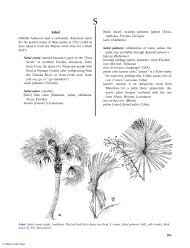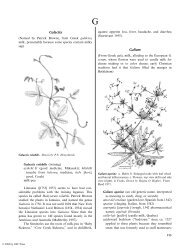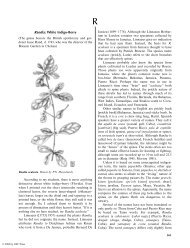Herba Cana - Northeastern Illinois University
Herba Cana - Northeastern Illinois University
Herba Cana - Northeastern Illinois University
You also want an ePaper? Increase the reach of your titles
YUMPU automatically turns print PDFs into web optimized ePapers that Google loves.
© 2004 by CRC Press<br />
The Ethnobotany 531<br />
waki used the root to treat rheumatism, as an emetic,<br />
and as a physic (King 1984). The Osage used the<br />
powdered root as a cathartic, gave it as an antidote for<br />
poison, and used it to ward off fever (Hunter [1823]<br />
1973). The Penobscot used May-apple to cure warts<br />
(Vogel 1970).<br />
Tiny quantities of roots, leaves, or green fruits are<br />
poisonous, and powdered root and resin can cause<br />
skin and eye problems. Podophyllum peltatum contains<br />
more than 15 biologically active compounds, including<br />
podophyllin, and a bitter resin containing lignins and<br />
flavonols (Diggs et al. 1999). Podophyllin, concentrated<br />
in the root, is the drug of choice for treating<br />
genital warts although it is highly allergenic (Foster<br />
and Duke 1990). Etoposide, a semisynthetic derivative<br />
from the roots, is the first-choice drug for treating<br />
small-cell lung carcinoma and testicular cancer (Foster<br />
and Duke 1990, Coffey 1993, Hocking 1997, Mabberley<br />
1997, Swerdlow 2000). Teniposide is used to treat<br />
brain tumors and childhood leukemia (Swerdlow<br />
2000). Podophyllum hexandrum has larger rhizomes<br />
than the American species and contains more resins<br />
(12%) with about twice the content of podophyllotoxin<br />
than P. peltatum (Hocking 1997). Podophyllum<br />
hexandrum also contains podophyllotoxin, desoxypodophyllotoxin,<br />
isopicropodophyllone, astragalin, hyperin,<br />
quercetin, and kaempferol (Hsu 1986).<br />
The major disperser of P. peltatum in Delaware<br />
forests is the box turtle (Mabberley 1997). Apparently,<br />
that is why the herbs can get away with ‘‘hiding’’ their<br />
fruits below the canopy of leaves where birds and<br />
many other animals have difficulty finding them.<br />
Polygala: Milkworts<br />
(From Greek poly, much, gala, milk)<br />
Milkworts are everywhere in the pine flatwoods in<br />
late April. Sometimes thousands of plants belonging<br />
to nine species will be in view on ridges and swales. As<br />
I look at the plants, I can almost see the Greek<br />
physician and author Pedanios Dioscorides from the<br />
Polygala.a.Polygala cruciata.b.Polygala lutea.c.Polygala grandiflora.d.Polygala rugelii. e through k. Polygala nana. e. Habit.<br />
f and h. Keel, two views. g. Flower. i. Filaments connected to petals. j. Mature seed. k. Pistil. a through d drawn by<br />
P.N. Honychurch. e through k drawn by Vivian Frazier. From Correll and Correll 1972.





